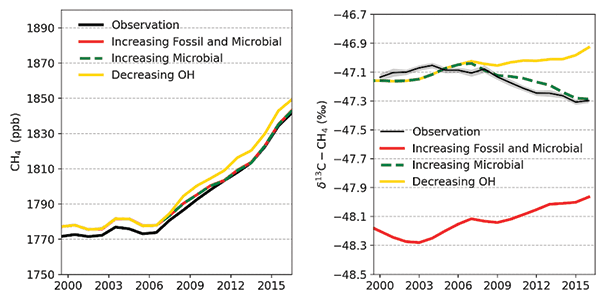New analysis: wetlands, other microbial sources fueling rise of atmospheric methane

The sudden and sustained rise in atmospheric levels of the potent greenhouse gas methane since 2007 has posed one of the most significant and pressing questions in climate research: Where is it coming from? Fossil fuel emissions? Biological sources? A diminished capacity by the atmosphere to break down methane? A climate tipping point?
The question has been the subject of intense scientific interest for a decade. Now, a research team led by Xin Lan, a CIRES scientist working at NOAA’s Global Monitoring Laboratory, has tested the leading theories for surging methane levels by analyzing the stable carbon isotope ratios (δ13C-CH4) from methane captured in a large set of global air samples to determine if one of the theories is more feasible than the others.
Their paper was published in Global Biogeochemical Cycles.

Globally averaged atmospheric CH4 (top) and δ13C-CH4 (bottom) from NOAA’s Global Greenhouse Gas Reference Network. The blue curves are derived from weekly data and the black curves are annual means. The data from 2020 are preliminary.
Lan said the data pointed to microbial sources, such as natural wetlands, shallow lakes and rivers, and human-managed sources like livestock, landfills, rice paddies, and wastewater treatment. “Our analysis indicates that methane emissions from fossil fuels are unlikely to be the dominant driver of the post-2006 increase,” said Lan. “The long-term change can’t be explained by a reduction in the rate at which the atmosphere degrades methane either.”
Methane, which is far less abundant but 28 times more potent than CO2 at trapping heat over a 100-year time frame, is emitted to the atmosphere from three major source categories: fossil fuels, microbials and biomass/biofuel burning. If microbial methane emissions from wetlands are increasing due to climate change, then that would constitute an extremely concerning climate feedback cycle that could amplify warming, Lan said.

Modeled global mean CH4 (left) and global mean δ13C-CH4 (right) compared with observations. The scenario “Increasing Fossil and Microbial” attributes the post-2006 increase almost equally to fossil fuel and microbial emission sources. The magnitude of fossil emissions in this scenario is about 30 Tg/yr lower than the other two scenarios. The scenario “Increasing Microbial” attributes all of the post-2006 increase to microbial emissions. The scenario “Decreasing OH” assumes an 8% decrease in atmospheric OH, the major CH4 sink, as the primary driver for the post-2006 global CH4 increase. “Increasing Fossil and Microbial” and “Decreasing OH” are rejected due to poor comparisons with δ13C-CH4 observations.
Why is carbon isotope analysis so valuable?
Carbon isotope analysis allows scientists to identify the source of the carbon in a methane sample by carefully measuring the ratio of the most common form of carbon, carbon-12, and its stable isotope, carbon-13 (13C), which has one extra neutron. That means 13C is ever so slightly heavier than 12C.
Fossil fuels, like the methane in natural gas, have unique signatures in the ratio of 13C to 12C. Methane produced from modern microbes in settings such as wetlands, landfills, and agriculture have just a small amount of 13C, so the signature of microbial methane is “lighter” than methane from fossil fuels.
Lan’s research team evaluated leading theories by comparing carbon isotope measurements performed by the Institute of Arctic and Alpine Research (INSTAAR) at the University of Colorado Boulder to an updated global inventory of methane stable isotope signatures from fossil fuel, microbial and biomass/biofuel burning sources. Researchers then plotted the multi-year trend of isotope ratios obtained from atmospheric observations, and then tried to find the global methane budget scenarios that could best match the observations.
Sylvia Michel, who oversees the stable isotope measurements at INSTAAR, said their paper highlights the capability of carbon isotope analysis to differentiate between the fossil and microbial sources, and to evaluate competing estimates of sources and sinks that make up global methane budgets.
“When we first started to see the change in the carbon isotope ratios in 2008 in the data, we thought there might be something wrong with our calibrations,” said Michel. Quality controls within the lab, and comparisons with other groups that measure carbon isotopes of methane, helped confirm that the signal was real. “Xin’s modeling, with a much more comprehensive description of source signatures, is helping us make sense of the data that we’ve been seeing.”
The team also considered whether the increase of methane in the atmosphere could be due to a slowdown in the natural rate of methane decay since 2007, but they found this theory inconsistent with their measurements.
Long-term measurements show that around the same time that atmospheric methane started to rise, the ratio of heavier to lighter carbon isotopes in methane started to decrease—reversing a 200-year trend. Since microbial emissions are associated with the lowest 13C/12C ratios, the team concluded that the dominant driver for the post-2006 methane increases is most likely increased microbial emissions.
The study also provided new estimates on fossil fuel and methane emissions. Methane emissions from fossil fuel were estimated at between 130 and 152 million metric tons per year, significantly larger than the 108 million metric tons per year estimated by the Global Carbon Project. Their estimate of microbial contributions was between 360 and 420 million metric tons per year, more than double the amount from fossil fuels.
Co-authors on the team included scientists from NOAA, NASA, the University of Maryland, Purdue University, Dalhousie University, the European Commission Joint Research Center, the Italian National Institute of Geophysics and Volcanology, and the Environmental Defense Fund. The study was funded by NASA and supported by NOAA’s Global Monitoring Laboratory.
While Lan is confident about the finding, she said more research is needed to be able to assess the effectiveness of current or future actions aimed at reducing methane emissions, and to examine whether the long-term increase may be amplified by climate feedbacks.
“Fossil fuels may not be the primary driver of the increase in atmospheric methane, but there is still a great potential for the fossil fuel industry to help mitigate climate change by cutting its emissions,” said Lan. “Carbon isotope analysis will help tell us if their efforts are working.”
This story was written by NOAA Communications.